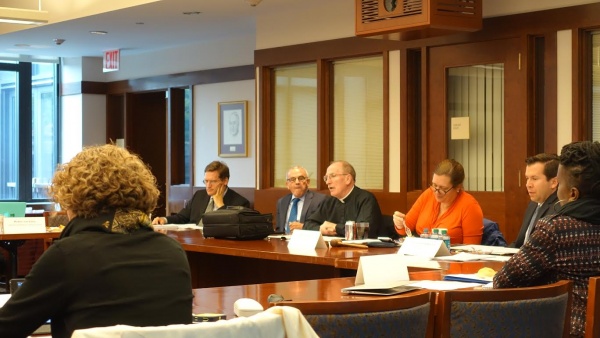Faculty Senate Discusses Racial Incidents, University Finances
Father McShane, president of Fordham University, was the first to speak at the meeting. (ANA FOTA/THE OBSERVER)
October 5, 2015
The Fordham Faculty Senate held their second meeting of the school year on Oct. 2nd, to address several matters, including diversity issues on both campuses and plans for the University’s future.
The issue of diversity was discussed throughout the meeting, with several members expressing their concerns. The senatos asked to remain unindentified. One senator called the lack of black faculty in the Gabelli School of Business (GSB), “appalling.” University Provost Stephen Freedman, Ph.D., participated in the discussion, saying “I would prefer that we have funds available to incentivize faculty to hire more people of color, but we would never go against a faculty recommendation.”
“I hope we don’t talk about this just because of recent events,” a member of the Senate said and was quickly reassured by the Provost that this is not the case.
“It’s something that we need to consider, especially after years of having this conversation,” another member of the Senate argued.
A third senator weighed in, “first and foremost in my mind is this question of our disconnect,” referring to the lack of communication between students and faculty.
Before the end of the meeting, Anne Fernald, senate president and associate professor of English and director of writing and composition at Lincoln Center, brought up the “racist” carving at Rose Hill, proposing the presence of student leaders at the Senate’s next meeting, to voice their concerns regarding the response of administration and faculty to the two racially-charged incidents that occurred at Rose Hill in September.
Amir Idris, professor and chair of the African and African-American Studies department has been assigned to designate students eligible to represent the student body, by talking in front of the senate. “The racist carving itself is not as important as the climate that led someone to feel comfortable doing this,” Fernald said. The incidents were treated as part of a larger problem, embedded in the culture at Fordham.
Freedman held a presentation regarding the broader issue of diversity at Fordham. His hopes for the future include shifting the academic focus more towards the research aspect of the institution. “It’s not that we’re not doing well, but I think we can do better,” he said, calling for interdisciplinarity and collaboration between the different departments and schools under the Fordham umbrella.
Freedman cited Gabelli School of Business (GSB) faculty helping in the Arts programs and vice versa as an example. He also expressed his hopes that such actions will not lead to a culture of competitiveness at Fordham. “Should we,” the Provost asked, “have a more proactive approach to departments who are willing to hire a second candidate for diversity reasons? If we did and if I made that decision, would that go counter to the views of departments who might be losing the position of a very effective person, as a result of this diversity measure?”
One senator agreed with this course of action, saying, “potential for research and the ways for us to work together for social good, to address social injustice, are things Fordham is uniquely poised to do.”
The second half of the meeting was predominantly led by the members of the Continuous University Strategic Planning (CUSP) committee, particularly Committee President J. Patrick Hornbeck II, associate professor and chair of the theology department.
According to Hornbeck, the committee’s main goal is “to generate a series of broad goals regarding what the university should look like,” with a focus on the “distinctly unsexy topic of process and strategy,” designing a direction for reshaping the university over the next decade. According to him, the committee has made strides regarding the issue of cooperation between two campuses with different academic focuses.
Among the issues raised by CUSP was Fordham’s financial vulnerability. This is due to it being overly tuition dependent, meaning most of its financial means come from student payments. This year, both Fordham College at Rose Hill (FCRH) and Fordham College at Lincoln Center (FCLC) had a larger number of enrollment than expected, with 50 more students at FCRH and 19 more at FCLC. However, other areas of the institution have registered lower enrollment rates, such as the Fordham Law School. Overall, undergraduate admission was over by 140 students.
The meeting was monitored by Fernald. First to speak was Rev. Joseph Michael McShane, S.J., president of Fordham University. He made a few announcements, among which was the expiration of the Federal Perkins Loan Program, which provided financial aid for Fordham students in need. The exact number of students that this will affect has yet to be determined.
McShane was present both at the White House reception to welcome the current pontiff and at the United Nations meeting held during Pope Francis’s visit to the United States. “You will notice that in his addresses throughout his trip, he followed a three part approach,” which was “classically Jesuit,” according to McShane. The three steps are engaging the audience by building a sense of identity, praising them and, lastly, challenging them. Prior to the visit, McShane had sent out four invitations towards the pontiff.
Fordham’s graduate schools are facing an increasingly competitive market and the high tuition costs do not facilitate higher enrollment rates. Presently, the university is financially secure due to the unexpected high number of undergraduate enrollment this year. “It is a testimony to our great program,” McShane stated, as Fordham sells “a great product in a great location. To protect our quality is to protect our future.”
As the representative body of university faculty, the Senate holds monthly meetings from September through May, alternating between the two campuses. It is comprised of 25 elected members, representing the two campuses of Fordham College and the graduate schools. Their November meeting will be held at Lincoln Center.












